Laser systems are proving invaluable for monitoring the terrestrial environment and for exploring the solar system.
Dr. Farzin Amzajerdian, NASA Langley Research Center
The growing importance of laser-based remote sensing instruments to NASA scientists and space mission designers is not surprising. Lasers offer clear advantages over passive and active radio-wave measurements for many space applications. These advantages include excellent spatial resolution, nonreliance on natural light sources, and the ability to aim and scan. The past success of lidar instruments in space, combined with the potential of laser remote sensing to outperform conventional instruments, has made the NASA scientists and engineers bolder and more ambitious in their planning of future space missions. There are more than 10 lidar instruments being planned for launch over a seven-year period from 2013 to 2020.
NASA currently has four major lidar instruments in space, with another one to be launched later this year. The IceSat (Ice, Cloud and land Elevation Satellite) and Calipso (Cloud-Aerosol Lidar and Infrared Pathfinder Satellite Observation) are Earth science missions providing valuable atmospheric data for monitoring global climate changes. The other three instruments are part of planetary missions: Mercury Laser Altimeter (MLA) as part of the Messenger mission, Mars Meteorological Lidar onboard the Phoenix Lander, and Lunar Orbiter Laser Altimeter (LOLA) onboard the Lunar Reconnaissance Orbiter. Table 1 summarizes the specifications of these instruments and their launch dates.
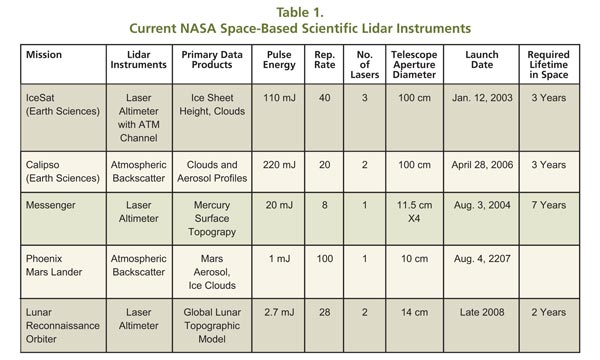
All the lidar instruments use a diode-pumped Nd:YAG laser as their transmitter source and incorporate some level of redundancy by using backup lasers to ensure long operational lifetime in space. IceSat, Calipso and the Mars Meteorological Lidar instruments use external cavity doublers to generate 532-nm radiation along with the fundamental 1064-nm beam. The 532-nm beam profiles the atmospheric aerosols, while the 1064-nm beam is used for denser aerosol plumes, clouds or ground targets. IceSat lidar uses its 1064-nm beam to measure the height of Earth’s polar ice sheets and to monitor changes over time. Changes in ice sheet elevations are an important indicator of global climate change, and they influence the global sea level, which can have a profound impact on life on Earth.
Calipso uses both laser wavelengths to collect spatially resolved cloud and aerosol data. The combination of three signal returns (1064 nm and two orthogonal polarizations at 532 nm) allows the scientists to extract information about aerosol concentration and the water and ice content of clouds. The improved information on global cloud coverage, on the altitudes of clouds, and on their water and ice contents is critical to better weather forecasting and to more accurate climate models.
Atmospheric aerosols also affect the weather and global climate changes. Depending on their concentration and composition, they can reflect sunlight away from Earth, causing the atmosphere to cool or absorb sunlight, which warms the atmosphere. Figure 1 illustrates the Calipso instrument designed to measure atmospheric aerosol and clouds.
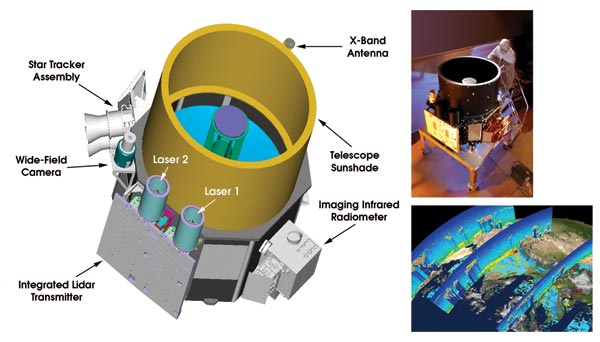
Figure 1. The Calipso payload consists of lidar as the primary instrument along with the imaging infrared radiometer and the wide-field camera (left). The lidar transmits three laser beams, and the backscattered signals are collected by a 1-m-diameter telescope and directed to three receivers. An active boresight system maintains coalignment between the transmitter and the receiver. The imaging infrared radiometer and the wide-field camera are coaligned with the lidar to provide additional data for determining the cloud emissivity and ice-particle size distribution. The Star Tracker provides the laser pointing information needed for registering the location of each lidar profile. On the top right, payload integration at Ball Aerospace and Technologies is shown. A pictorial representation of the lidar measurements is shown on the bottom right.
Unlike IceSat and Calipso, the Mars Meteorological Lidar onboard the Phoenix Lander operates from a stationary platform on the planet’s surface, looking upward. It measures the atmospheric aerosol concentration and CO2 ice clouds, gathering information that could lead to a better understanding of the Mars climate and atmospheric processes.
The laser altimeter instruments (MLA and LOLA) orbiting Mercury and the moon, respectively, simply measure the distance to the surface as they orbit. After a large number of orbits, the collected data can be used to form global three-dimensional topographical maps.
IceSat has been in orbit since 2003 and Calipso since 2006, and both continue to operate and transmit data. Messenger (MErcury Surface, Space ENvironment, GEochemistry and Ranging) made its first flyby of Mercury in January 2008, making lidar measurements of the planet’s surface. The lidar onboard Messenger is expected to operate well beyond 2011, when the spacecraft settles into orbit around Mercury, after flybys in October 2008 and September 2009. The Mars Meteorological Lidar began operation soon after the recent successful landing of the Phoenix spacecraft in May 2008.
Future challenges
There are plans to use lidar technology for a wide range of applications because it can allow NASA to achieve its scientific and space exploration goals. The applications fall into four general categories:
• Earth Sciences: long-duration orbiting instruments providing glo-bal monitoring of the atmosphere and land.
• Planetary Sciences: orbiting or land-based instruments providing geological and atmospheric data from solar system bodies.
• Landing Aid: sensors providing hazard avoidance, guidance and navigation data.
• Rendezvous and Docking Aid: sensors providing spacecraft bearing, distance and approach velocity.
The reliance of Earth sciences on lidar technology is revealed clearly in the National Research Council (NRC) report “Earth Science and Applications from Space: National Imperatives for the Next Decade and Beyond,” published in 2007. The report reflects the consensus of the scientific community and is regarded seriously by NASA planners. It provides a list of 15 recommended missions for NASA to implement over the next decade. Seven of the 15 are based on lidar instruments, with the remaining missions divided between passive optical, radar and microwave technologies.
This fact reflects the scientific community’s belief that the ability of lidar to provide highly accurate atmospheric data on a global scale can profoundly help climate research. Table 2 lists the lidar missions recommended by the NRC and provides their associated cost as estimated by the NRC panel, reflecting their relative complexity.
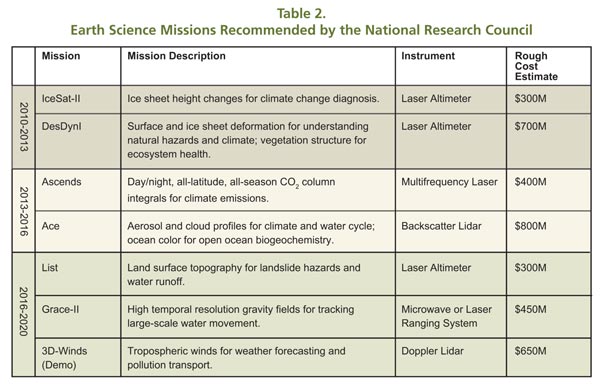
Some of the recommended lidar missions are based on previously flown instruments but strive for higher accuracy, resolution and coverage than their predecessors. IceSat-II and Ace are two such missions, building on the successes of IceSat and Calipso. However, most of the recommended lidar missions represent new measurements requiring considerably more complex instruments than previously flown. For instance, the 3-D Wind Lidar will use narrow-bandwidth pulsed lasers to measure the Doppler shift resulting from motion of atmospheric aerosols and molecules with the wind.
Therefore, the high-pulse-energy laser must employ an elaborate cavity control mechanism and must rely on a stable single-frequency continuous-wave laser as an injection-seeding source. Furthermore, a wind lidar requires precision pointing of the transmitted laser beam to allow extraction of the horizontal components of wind velocity. Precision scanning of the laser beam and collection of the returned radiation using an aperture >50 cm will be a major challenge.
Planetary science applications are focused on the geology and surface topography of the planets and the moon and on characterization of the Mars atmosphere. Besides the missions discussed earlier, NASA will continue deploying laser altimeters to orbit various solar bodies. Specifically, LOLA, scheduled for launch later this year, is expected to orbit the moon for at least two years, providing a 3-D map of the entire lunar surface. This information will be critical in landing site selection and in designing future robotic and manned landing missions to the moon.
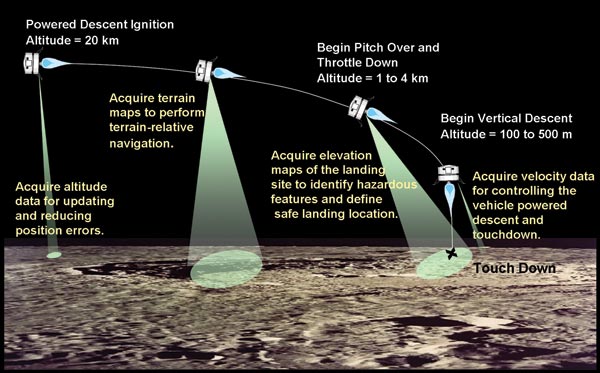
Figure 2. Lidar technology can enable precision landing and help avoid hazards during landing. It can provide altitude data from up to 20 km above the ground to reduce vehicle position errors. By providing a relatively low resolution 3-D map of the terrain and comparing it with a reference map of the landing area, the vehicle position relative to the designated landing site can be determined to within tens of meters. As the vehicle continues to descend, high-resolution 3-D maps of the terrain can be obtained to identify the hazardous features and to locate a safe landing site. Precision lidar vector ground velocity measurements will ensure a soft landing at the desired safe area.
The application of lidar technology for understanding the Mars atmosphere is starting to attract the attention of NASA scientists. The 2006 NASA report, “Mars Scientific Goals, Objectives, Investigations, and Priorities,” outlines a series of measurements critical to understanding the Mars atmosphere and the search for evidence of life. Many of these measurements — including atmospheric density variations, seasonal and diurnal cycles, aerosol concentration profiles and detection of water vapor — are best achieved by lidar instruments.
Landing aid is another important application of lidar technology in space. The ability of lidar technology to provide 3-D elevation maps of the terrain, high-precision measurements of distance to the ground and the approach velocity can enable safe landing of large robotic and manned vehicles with a high degree of precision at the designated site. Future planetary exploration missions will require precision soft landings to target scientifically interesting sites near hazardous terrain features such as escarpments, craters, slopes and rocks.
Although the landing accuracy has steadily improved to approximately 10 km for Mars landings and 1 km for the moon, a drastically different guidance, navigation and control concept is needed to meet future mission requirements. For example, future rovers will require better than a 1-km landing accuracy for Mars and better than a 30-m landing for the moon.
Currently, NASA is actively advancing the lidar technology for future lunar landing missions through its Autonomous Landing and Hazard Avoidance Technology (Alhat) project. This program is developing 3-D imaging and Doppler-velocity lidar as part of the landing guidance, navigation and control system. The lidar sensors being developed under Alhat will enable safe soft landings of large robotic, cargo and crewed vehicles with a high degree of precision at the designated landing site and under any lighting conditions.
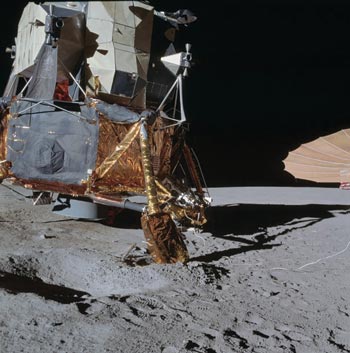
Figure 3. Even though Apollo missions targeted well-surveyed landing sites, they still experienced some close calls. An example is the Apollo 14 shown above, with one of its legs within inches of a hole. A 3-D imaging lidar will be able to detect such hazards.
Rendezvous and docking aid for the future Crew Exploration Vehicle, which will replace the space shuttle and will be used for manned mission to the moon, may rely on a lidar sensor. The lidar technique is being considered for providing the critical distance, the approach velocity and relative orientation of the docking port during the rendezvous and docking maneuver. The precision and high update rate offered by the lidar could be the key for mating the vehicle with the International Space Station. These capabilities also will be crucial in the human mission to the moon, for mating the lunar crew module with the Earth re-entry vehicle that will be awaiting it in the moon orbit.
Lidar, already widely used by NASA, will play an increasingly important role in the future. It will find applications both as a scientific instrument and as a navigational tool in many future missions. Despite past successful lidar missions, deployment of laser systems in space remains a challenge that is magnified by the increasing demand for accuracy and by the requirements of new measurements. We will meet this challenge with complex and sophisticated lidar instruments.
Meet the author
Farzin Amzajerdian is a senior research scientist at NASA Langley Research Center in Hampton, Va.; e-mail: [email protected].